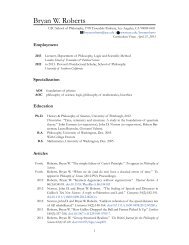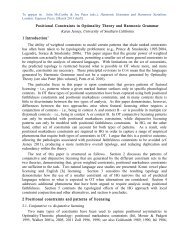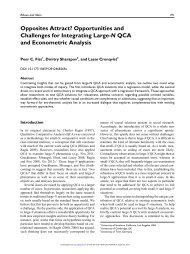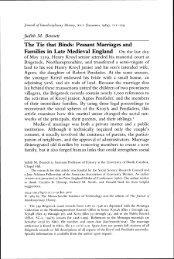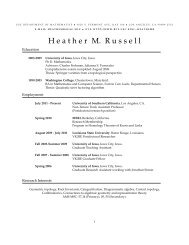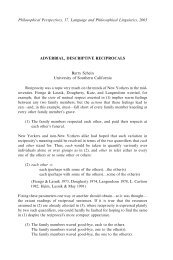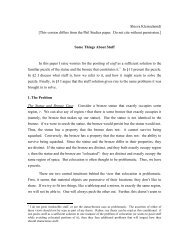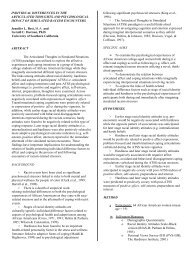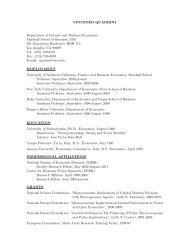The Diffusion of Ideas over Contested Terrain - Personal World Wide ...
The Diffusion of Ideas over Contested Terrain - Personal World Wide ...
The Diffusion of Ideas over Contested Terrain - Personal World Wide ...
You also want an ePaper? Increase the reach of your titles
YUMPU automatically turns print PDFs into web optimized ePapers that Google loves.
REFERENCES<br />
Abrahamson, E.<br />
1991 “Managerial fads and fashions:<br />
<strong>The</strong> diffusion and rejection<br />
<strong>of</strong> innovations.” Academy<br />
<strong>of</strong> Management Review,<br />
16: 586-612.<br />
Ahmadjian, C., and P. Robinson<br />
2001 “Safety in numbers: Downsizing<br />
and the deinstitutionalization<br />
<strong>of</strong> permanent employment<br />
in Japan.”<br />
Administrative Science Quarterly,<br />
46: 622–654.<br />
Allison, P. D.<br />
1984 Event History Analysis:<br />
Regression for Longitudinal<br />
Event Data. Beverly Hills, CA:<br />
Sage.<br />
1995 Survival Analysis Using the<br />
SAS System: A Practical<br />
Guide. Cary, NC: SAS Institute.<br />
1999 Logistic Regression Using the<br />
SAS System: <strong>The</strong>ory and<br />
Applications. Cary, NC: SAS<br />
Institute.<br />
Anderson, R. C., and D. M. Reeb<br />
2002 “Founding-family ownership,<br />
corporate diversification, and<br />
firm leverage.” Working<br />
paper, Kogod School <strong>of</strong> Business,<br />
American University.<br />
Atkinson, L., and J. Galaskiewicz<br />
1998 “Stock ownership and company<br />
contributions to charity.”<br />
Administrative Science Quarterly,<br />
33: 82–100.<br />
#2144-ASQ V49 N4-December 2005—file: 49401-fiss<br />
gesting the distinct possibility <strong>of</strong> a shareholder value backlash<br />
among German firms in the future. We believe our theoretical<br />
perspective on diffusion, with its emphasis on sociopolitical<br />
factors, would also be well-suited to understanding when<br />
and why such a backlash would occur.<br />
Our research examines an ongoing process whose outcome<br />
is still not fully known, and conclusions about the ultimate<br />
extent <strong>of</strong> convergence on a shareholder-centered g<strong>over</strong>nance<br />
model in Germany have to remain preliminary. Nevertheless,<br />
our findings also point to an active process <strong>of</strong> symbolic management<br />
in convergence, in which surface compliance is substituted<br />
for deep compliance (Zajac and Westphal, 2004). <strong>The</strong><br />
picture that emerges is one <strong>of</strong> a mixture <strong>of</strong> “shallow” and<br />
“deep” convergence and intracountry variation rather than a<br />
binary convergence/non-convergence distinction measured at<br />
the country level. <strong>The</strong> significant non-adoption <strong>of</strong> a shareholder<br />
value orientation among German firms redirects our attention<br />
to questions <strong>of</strong> implementation and enforcement, and<br />
future research may further investigate whether <strong>over</strong> the<br />
longer term, powerful owners or other stakeholders will force<br />
firms to match appearance and actions or whether firms’<br />
growing sophistication with the use <strong>of</strong> normatively appropriate<br />
language and appearance will suffice in appeasing stakeholder<br />
groups.<br />
Bagwell, L. S.<br />
1991 “Shareholder heterogeneity:<br />
Evidence and implications.”<br />
American Economic Review,<br />
81: 218–221.<br />
1992 “Dutch auction repurchases:<br />
An analysis <strong>of</strong> shareholder<br />
heterogeneity.” Journal <strong>of</strong><br />
Finance, 47: 71–105.<br />
Barr, P. S., J. L. Stimpert, and<br />
A. S. Huff<br />
1992 “Cognitive change, strategic<br />
action, and organizational<br />
renewal.” Strategic Management<br />
Journal, 13: 15–36.<br />
Bartunek, J. B.<br />
1984 “Changing interpretive<br />
schemes and organizational<br />
restructuring: <strong>The</strong> example <strong>of</strong><br />
a religious order.” Administrative<br />
Science Quarterly, 29:<br />
355–372.<br />
Baums, T., and C. Fraune<br />
1995 “Institutionelle Anleger und<br />
Publikumsgesellschaft.” Die<br />
Aktiengesellschaft, 40:<br />
97–112.<br />
Becker, G.<br />
1974 “A theory <strong>of</strong> social interactions.”<br />
Journal <strong>of</strong> Political<br />
Economy, 82: 1063–1093.<br />
530/ASQ, December 2004<br />
Belliveau, M. A., C. A. O’Reilly III,<br />
and J. B. Wade<br />
1996 “Social capital at the top: <strong>The</strong><br />
effects <strong>of</strong> social similarity and<br />
status on CEO compensation.”<br />
Academy <strong>of</strong> Management<br />
Journal, 39: 1568–1593.<br />
Black, S. W., and M. Moersch<br />
1998 Competition and Convergence<br />
in Financial Markets:<br />
<strong>The</strong> German and Anglo-American<br />
Models. New York: Elsevier<br />
Science.<br />
Bonacich, P.<br />
1972 “Factoring and weighting<br />
approaches to status scores<br />
and clique identification.”<br />
Journal <strong>of</strong> Mathematical Sociology,<br />
2: 113–120.<br />
Boyd, B., W. O. Carroll, and M.<br />
Howard<br />
1996 “International g<strong>over</strong>nance<br />
research: A review and agenda<br />
for future research.”<br />
Advances in International<br />
Comparative Management,<br />
11: 191–215.<br />
Bradley, M., C. A. Schipani, A. K.<br />
Sundaram, and J. P. Walsh<br />
1999 “<strong>The</strong> purposes and accountability<br />
<strong>of</strong> the corporation in<br />
contemporary society: Corporate<br />
g<strong>over</strong>nance at a crossroads.”<br />
Law and Contemporary<br />
Problems, 62: 9–86.



